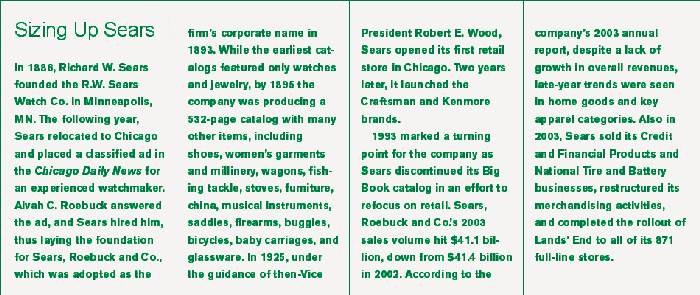]> An historical retail milestone is analyzed by the licensing industry. In late November, Sears, Roebuck and Co. and Kmart Holding Corporat
April 6, 2018

]>
An historical retail milestone is analyzed by the licensing industry.
In late November, Sears, Roebuck and Co. and Kmart Holding Corporation took the retail industry by surprise, signing an $11 billion merger agreement that will combine Sears and Kmart into the third-largest U.S. retailer under the moniker Sears Holding Corporation, with approximately $55 billion in annual revenues; 2,350 full-line and off-mall stores; and 1,100 specialty stores. The merger, which is expected to close by the end of March, calls for Sears and Kmart to continue operating separately under their respective brand names. 
Although neither Sears nor Kmart was willing to comment, published reports on both company Websites note that Sears Holdings will feature a powerful home appliance franchise, as well as strong positions in tools, lawn and garden, home electronics, and automotive repair and maintenance. The company also will have a broad apparel offering, including well-known labels such as Lands' End, Jaclyn Smith, and Joe Boxer, as well as the Apostrophe and Covington brands. In addition, it will carry Martha Stewart Everyday products, which now are offered exclusively by Kmart in the U.S. and by Sears Canada in Canada. Kmart specialty retail stores will continue to carry their current lineup in proprietary home and fashion lines including Thalia Sodi, Jaclyn Smith, Joe Boxer, Martha Stewart Everyday, Route 66, and Sesame Street. According to the reports, the combined business will benefit from improved operational efficiency in areas such as procurement, marketing, information technology, and supply chain management. Despite the talk of enhanced brand portfolios, $300 million in annual cost savings, and improved scale through a national footprint of nearly 3,500 retail stores, the question remains: How will consumers respond? 
According to Wendy Liebmann, president, WSL Strategic Retail, "While size alone may provide operation efficiencies and potential savings for shoppers, the 'every day low price' position is well filled by Wal-Mart, just as Target satisfies the 'expect more' role." Perhaps by melding Sears' hard goods (think Kenmore and Craftsman brands) with Kmart's soft brands such as Martha Stewart, Jaclyn Smith, and Thalia, the discounter and the department giant will create a compelling selection of power brands. "If they pool their war chest of brand names and become one, they may solve the 'brand image' problem that has eluded both," says Liebmann. On the flip side, many analysts argue, the Sears-Kmart combo is less about retailing than it is about real estate, enabling Sears to capitalize on Kmart's 1,500 freestanding and strip-mall outposts. This, of course, remains to be seen. Here, License! gets the inside scoop on the mega-merger from the perspective of licensors, licensees, and industry analysts.

Although now viewed as antiquated, Kmart and Sears were once at the top of their respective markets. In the 1960s Kmart took its discount-store concept nationwide and outpaced rivals Wal-Mart and Target. Sears, meanwhile, was the first department store to embrace suburban malls. But several decades worth of missteps led to Sears' lackluster store growth and Kmart's 2002 bankruptcy filing. Kmart was once very aggressive when it came to licensing, says Liebmann. But, she notes, in the last few years other retailers have taken a more active role. According to one licensor, Sears and Kmart have been a little sleepy when it comes to licensing. "Our hope," the licensor continues, "is that in coming together, the retailers will lend more support to the industry." Neither was considered a strong player in the toy industry, says Jay Foreman, president of Play Along Toys, a division of Jakks Pacific, "but if they can pool their resources and consolidate two brand names into one brand name and the locations into a healthier single unit, I would speculate that it's a positive for the industry. There's no stopping the momentum of consolidation, and I feel it's better to have three or four strong retailers than to have 20 to 30 weaker, independent retailers." Perhaps, speculates Foreman, the merger should be a roadmap for other retailers in the business. However, several licensors and licensees voice concern over further consolidation of the retail landscape. "Now you only have one decision maker, whereas before you had the chance to try both retailers," says one licensor. It is especially difficult for studio properties, notes another, since they are always looking for retail outlets. 

Perhaps the biggest winners to emerge from the merger are the brands themselves. "The merger allows the retailers to take premium brands and place them into an environment they've never been before," says Marshal Cohen, chief industry analyst, NPD Group. "Suddenly, the brand portfolio will be increased." Brands from Craftsman to Martha Stewart Everyday instantly doubled their audience. Analysts speculate that Martha's brand now will begin to appear on Sears' household appliances and will make its debut inside the retailer's new Sears Grand big-box stores (which began opening in September 2003). With a range of products from milk to refrigerators to books, Sears Grand stores are designed to compete with stand-alone stores such as Wal-Mart and Home Depot, and, if the company has its way, will lure big-box shoppers looking for higher-quality merchandise. "I imagine nobody will be able to compete with Wal-Mart on price," notes one apparel licensee, "so they will have to position themselves differently in order to remain viable." Most analysts agree that the success of the Sears Grand concept spells death for the Kmart nameplate, although the company took pains to deny this stance. In a sense, says Liebmann, "it's like choosing which twin will survive. I think if they get rid of real estate that doesn't work, but give the stronger of the two brands a chance to survive, it ultimately becomes a smart marketing strategy." Even so, it remains unclear whether Sears' acquisition of off-mall locations will drive new consumers through the door. One thing that is clear in speaking with various licensees and licensors is the need to be even more competitive and more retail focused. "Licensed business hasn't even scratched the surface yet, but it's going to affect both retailers much more dramatically now with this merger," says Cohen. "The stakes are higher. If you don't succeed in one retailer, do you have as many available avenues in the other?"
You May Also Like






